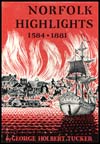Chapter 21
Methodism in Early Norfolk
The Reverend Robert Williams, a native of England, was the first Methodist to preach in Norfolk.
According to "The Beginnings of American Methodism" by John O. Gross (1961), Williams, who had been proclaiming the Gospel along the highways and byways of Ireland, resolved to be the first itinerant Methodist preacher to arrive in the British colonies.
Before setting out, Williams sold his horse to pay his debts. Since he did not have the money to pay for his passage, he set out for the port carrying his saddlebags on his arm. There an Irish friend paid for his passage, and he sailed for America.
William Warren Sweet in his "Virginia Methodism: A History" (1955) gives two versions of how Williams arrived in Norfolk.
The first account says he arrived from England on a Baltimore-bound ship in 1769. After leaving the vessel he proceeded up Main Street with his Bible and hymnbook in his pockets until he came to a house that was advertised for rent.
Taking up his stand on the steps, he began to sing and soon attracted a motley crowd. Telling of his purpose in coming to America, he asked if anyone would give him a night's lodging.
At that point, a woman, whose ship-captain husband was away at sea, invited Williams to come home with her, whereupon Williams repaid her hospitality by converting her to Methodism.
The account ends on a strange note of extrasensory perception. The woman's conversion was revealed to her husband by some mystical process, and he duly entered what was reveal to him in the ship's log, only to have it corroborated when he returned home.
The second account states that Williams first came to Norfolk in 1772, and a contemporary observation jotted down by a Norfolkian of that time added that Williams "mounted the highest steps of the courthouse (the Norfolk County Court House at the head of Market Square) and commenced to singing 'Come Sinners to the Gospel Feast' and I looked out at the door and said to my shop mates there is a crazy fellow at the courthouse and I will go and see him."
Williams did not receive a very cordial welcome in Norfolk because his hearers felt that his sermons contained too much hellfire and damnation. As a result, he moved his activities to Portsmouth, where he established a Wesley Society that eventually grew into the Monumental United Methodist Church of today.
Williams was followed in the Norfolk area by the Rev. Joseph Pilmoor, another Englishman, who is credited by historians for actually establishing the Methodist Church in Norfolk. Pilmoor recorded that when he was passing through Portsmouth on his way to Norfolk he came upon two men at the ferry who were "swearing most horribly."
"If I had been brought to this place blindfolded," he wrote, "I should have known I was near Norfolk."
Despite its initial setbacks, Methodism in Norfolk eventually took root and by 1775, when the Reverend Francis Asbury visited the borough, he found the Norfolk Methodists were worshiping in "an old, shattered building which had formerly been a playhouse."
The destruction of Norfolk during the Revolutionary War scattered the Norfolk Methodists for a while, but by 1793 they had established their first regular church on Fenchurch Street. Since the ground in that area was marshy, the church was built upon blocks eight feet high to protect it from being flooded by high tides.
This church served the Norfolk Methodist congregation until February 1800, when a lot was purchased on Cumberland Street on a site now occupied by a parking lot for Old St. Paul's Episcopal Church.
The first brick church erected on this property in 1802, known as the Cumberland Street Methodist Church, was the mother church of all the Methodist congregations in Norfolk today.
Chapter
22
The Burning of Norfolk
Norfolk Highlights 1584 - 1881

See the "Table of Contents" for links to every chapter in Norfolk Highlights 1584 - 1881 by George Holbert Tucker.
